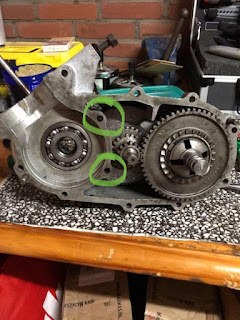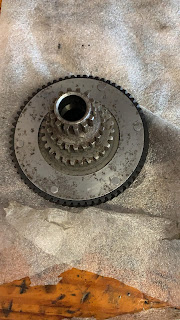So we now have the old lady safely stowed away. And an ACMA Vespa engine ready
for surgery. But why did you buy that second engine, I hear you ask? Well that is because we are not only going to breath back life into
this old lady, we are doing something else. A facelift is not the right metaphor
here, it’s more like we are going to give her a souped up pacemaker, load her
up on doping and get her ready to run the quarter mile at the next Olympics.
What’s that, you say, yes in short we are using the donor ACMA Vespa engine to tune
it up to more than twice (close to thrice (is that even a word?)) the HP! The
original VESPA engine we will keep nice and standard and tuck away somewhere dry and
dark.
Now back to the surgery, long story short, so... I live with my parents...
No I am not otherwise homeless, it's just that after I returned from Abu Dhabi
(see post 1) I bought a house that I am still renovating. Now why is this
relevant you ask, well since space is sparse in my parents house I'm performing this surgery on
an area the size of an A4 sheet of paper. And yes I would like some brownie points for that.
The area I have available is a small cluttered table
in the attic. Below picture shows basically what we will need to do to Vespa engine block:
First step, take off the cylinder head. This engine has it cylinder attached with three bolts opposed to all newer Vespa's that have four bolts. Unscrewing these bolts went smooth enough, quick inspection shows the head and the cylinder itself are in decent nick, no scratches, no strange discoloration, so prospects are good!
Next we take off the entire cylinder so we can inspect the piston proberly. This requires a little bit of wiggeling because you have to slide the cylinder sleeve out of the casing, but again smooth sailing. Even the piston was in great nick, no cracks or scratches (too bad it's not going te be used anymore).
On the above picture we can clearly see the two channels. I'm no expert by any means but the channels make it possible to tune this engine as opposed to one transfer port version. I believe this engine block has two channels for better release of, and intake of air. This gif shows the process.
https://qph.fs.quoracdn.net/main-qimg-f7dceb754942aa9b217dfc9868404c18
Now we started taking off the flywheel. This was little bit more cumbersome without the right tools but we managed. Actually one fin of the flywheel was already broken off probably from past attempts to remove the flywheel while blocking it with a screwdriver against the engine casing. Bloody babarians...
Now underneath the flywheel we will find the ignition plate that holds the coils, condensator and the contact points, basically everything we need to create a spark to ignite the fuel mixture in the cylinder (and generate power for the lights and horn). But, we don't or we didn't.
Two coils are missing on the statorplate which I believe are the coils that provide the power to the lights etc. But this makes the decision to upgrade from a 6v magnetic to a 12volt electrical system easy. 12 volts it will be.
Next splitting the casings (we had to remove some other bits and bobs, clutch cover, flywheel cover etc.). I wasn't expecting this to be easy since the casings had been stuck together for quite a many year. But with some gentle wiggling and some subtle nudges with a huge hammer, it began to move.
Victory! The insides look quite ok, the gears are in good nick, no cracks in the casing and there were no pieces of metal lying around nromally indicating breakage and wear and tear. The bearings sound a bit crunchy so they will need replacement. Then the last issue arose, I couldn't get the axle out from the case. Some googeling and some advice from vespaforum.be eventually, basically led to me banging on it till it released. Voila, full split!
I then proceeded taking out all the inner parts, the gears and cogs used for drive train. Also i removed the gear selector and the clutch. The clutch plates were really cooked together with old oil and bad repairs (it looks like someone put some dots of silicon on the plates or something). But that will need a full replacement anyways.
Now the plan:
-Replace the standard 125 cylinder and piston with a Pinasco 160cc set (bigger combustion chamber)
-Replace the standard 19mm carburettor with a 22mm Pinasco (more fuel and air)
-Replace the 45mm cranckshaft with a 47mm (longer stroke for the longer cylinder)
-Replace the 6v ignition with a more stable 12v Flytech (more stable spark)
-Replace the clutch and a primary wheel with a Pinasco set (better traction to deal with the power increase)
-Replace the exhaust (better release of increased fumes).
I have worked on Vespa engines before, I did oils seal replacements, replaced some bearings, changed gaskets and fiddled about with cylinders and pistons, but a complete rebuild like this is new to me, but I am looking forward to it!





































